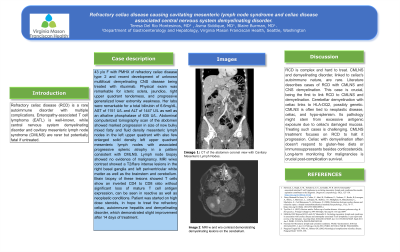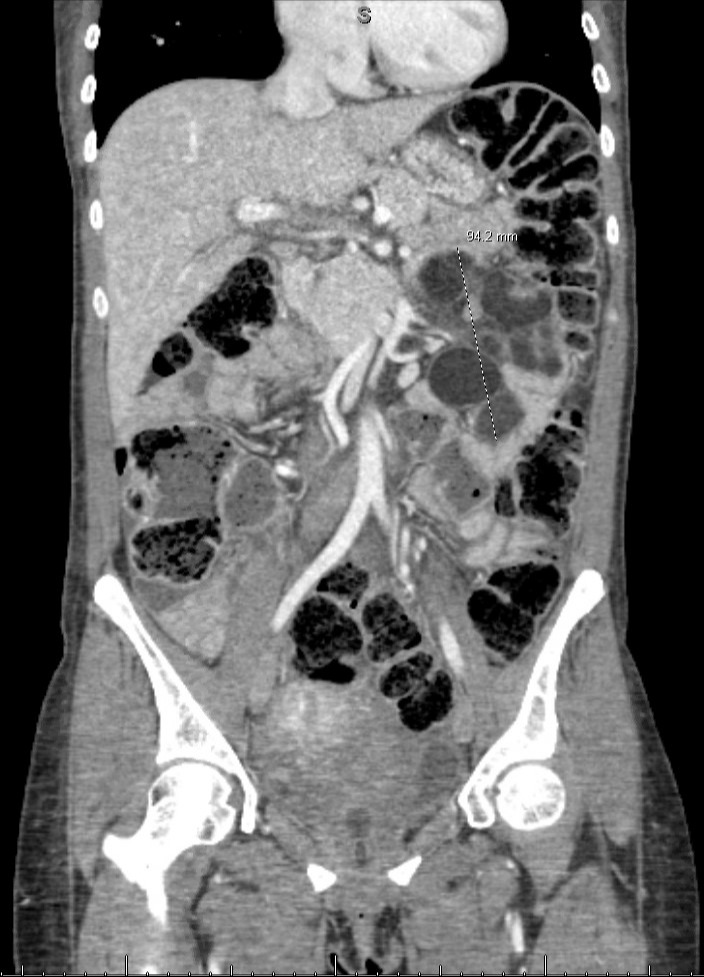Monday Poster Session
Category: Stomach
P3345 - Refractory Celiac Disease Causing Cavitating Mesenteric Lymph Node Syndrome and Celiac Disease Associated Central Nervous System Demyelinating Disorder
Monday, October 28, 2024
10:30 AM - 4:00 PM ET
Location: Exhibit Hall E

Has Audio

Teresa Del Rio Montesinos, MD
Virginia Mason Franciscan Health
Seattle, WA
Presenting Author(s)
Teresa Del Rio Montesinos, MD, Asma Siddique, MD, Blaire Burman, MD
Virginia Mason Franciscan Health, Seattle, WA
Introduction: Refractory celiac disease (RCD) is a rare autoimmune disorder with multiple complications. Enteropathy-associated T cell lymphoma (EATL) is well-known, while central nervous system demyelinating disorder and cavitary mesenteric lymph node syndrome (CMLNS) are rarer but potentially fatal if untreated.
Case Description/Methods: 43 y/o F with pmh of refractory celiac disease type 2 and recent development of unknown multifocal demyelinating CNS disease being treated with rituximab. Physical exam was remarkable for icteric sclera, jaundice, right upper quadrant tenderness, and progressive generalized lower extremity weakness. Her labs were remarkable for a total bilirubin of 6.6mg/dL, AST of 1151 U/L and ALT of 1447 U/L as well as an alkaline phosphatase of 635 U/L. Abdominal computerized tomography scan of the abdomen showed marked progression in size of now bulky mixed fatty and fluid density mesenteric lymph nodes in the left upper quadrant with also few enlarged solid density left upper quadrant mesenteric lymph nodes with associated progressive splenic atrophy in a pattern consistent with CMLNS. Lymph node biopsy showed no evidence of malignancy. MRI w/wo contrast showed a T2/flare intense lesions in the right basal ganglia and left periventricular white matter as well as the brainstem and cerebellum. Brain biopsy of these lesions showed T cells show an inverted CD4 to CD8 ratio without significant loss of mature T cell antigen expression, can be seen in reactive as well as neoplastic conditions. Patient was started on high dose steroids, in hope to treat the refractory celiac, autoimmune hepatitis and demyelinating disorder, which demonstrated slight improvement after 14 days of treatment.
Discussion: RCD is complex and hard to treat. CMLNS and demyelinating disorder, linked to celiac's autoimmune nature, are rare. Literature describes cases of RCD with CMLNS and CNS demyelination. This case is crucial, being the first to link RCD to CMLNS and demyelination. Cerebellar demyelination with celiac links to HLA-DQ2, possibly genetic. CMLNS is often tied to neoplastic disease, celiac, and hypo-splenism. Its pathology might stem from excessive antigenic exposure due to celiac's damaged mucosa. Treating such cases is challenging. CMLNS treatment focuses on RCD to halt progression. Celiac with demyelination often doesn't respond to gluten-free diets or immunosuppressants besides corticosteroids. Long-term monitoring for malignancies is crucial post-complication survival.

Disclosures:
Teresa Del Rio Montesinos, MD, Asma Siddique, MD, Blaire Burman, MD. P3345 - Refractory Celiac Disease Causing Cavitating Mesenteric Lymph Node Syndrome and Celiac Disease Associated Central Nervous System Demyelinating Disorder, ACG 2024 Annual Scientific Meeting Abstracts. Philadelphia, PA: American College of Gastroenterology.
Virginia Mason Franciscan Health, Seattle, WA
Introduction: Refractory celiac disease (RCD) is a rare autoimmune disorder with multiple complications. Enteropathy-associated T cell lymphoma (EATL) is well-known, while central nervous system demyelinating disorder and cavitary mesenteric lymph node syndrome (CMLNS) are rarer but potentially fatal if untreated.
Case Description/Methods: 43 y/o F with pmh of refractory celiac disease type 2 and recent development of unknown multifocal demyelinating CNS disease being treated with rituximab. Physical exam was remarkable for icteric sclera, jaundice, right upper quadrant tenderness, and progressive generalized lower extremity weakness. Her labs were remarkable for a total bilirubin of 6.6mg/dL, AST of 1151 U/L and ALT of 1447 U/L as well as an alkaline phosphatase of 635 U/L. Abdominal computerized tomography scan of the abdomen showed marked progression in size of now bulky mixed fatty and fluid density mesenteric lymph nodes in the left upper quadrant with also few enlarged solid density left upper quadrant mesenteric lymph nodes with associated progressive splenic atrophy in a pattern consistent with CMLNS. Lymph node biopsy showed no evidence of malignancy. MRI w/wo contrast showed a T2/flare intense lesions in the right basal ganglia and left periventricular white matter as well as the brainstem and cerebellum. Brain biopsy of these lesions showed T cells show an inverted CD4 to CD8 ratio without significant loss of mature T cell antigen expression, can be seen in reactive as well as neoplastic conditions. Patient was started on high dose steroids, in hope to treat the refractory celiac, autoimmune hepatitis and demyelinating disorder, which demonstrated slight improvement after 14 days of treatment.
Discussion: RCD is complex and hard to treat. CMLNS and demyelinating disorder, linked to celiac's autoimmune nature, are rare. Literature describes cases of RCD with CMLNS and CNS demyelination. This case is crucial, being the first to link RCD to CMLNS and demyelination. Cerebellar demyelination with celiac links to HLA-DQ2, possibly genetic. CMLNS is often tied to neoplastic disease, celiac, and hypo-splenism. Its pathology might stem from excessive antigenic exposure due to celiac's damaged mucosa. Treating such cases is challenging. CMLNS treatment focuses on RCD to halt progression. Celiac with demyelination often doesn't respond to gluten-free diets or immunosuppressants besides corticosteroids. Long-term monitoring for malignancies is crucial post-complication survival.

Figure: CT of the abdomen Coronal view with Cavitary Mesenteric Lymph Nodes.
Disclosures:
Teresa Del Rio Montesinos indicated no relevant financial relationships.
Asma Siddique indicated no relevant financial relationships.
Blaire Burman indicated no relevant financial relationships.
Teresa Del Rio Montesinos, MD, Asma Siddique, MD, Blaire Burman, MD. P3345 - Refractory Celiac Disease Causing Cavitating Mesenteric Lymph Node Syndrome and Celiac Disease Associated Central Nervous System Demyelinating Disorder, ACG 2024 Annual Scientific Meeting Abstracts. Philadelphia, PA: American College of Gastroenterology.
